62.3 Customizing User Functionality
You can control the functionality of certain aspects of the GroupWise WebAccess user interface. Any changes you make take effect the next time users log in to WebAccess.
62.3.1 Customizing the WebAccess User Interface with Your Company Logo
You can customize the WebAccess user interface to display your company logo. In the WebAccess Login window, you can replace the GroupWise envelope icon and the words “Novell GroupWise” in the upper left corner. In the main WebAccess window, you can replace the words “Novell GroupWise” in the menu bar.
The logo size for the WebAccess Login window must not exceed 215 pixels in width by 120 pixels in height.
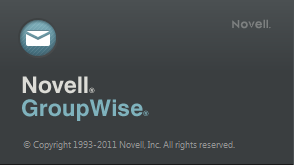
The logo size for the upper left corner of the main WebAccess window must not exceed 220 pixels in width by 40 pixels in height.

Interface customizations are established through the customization.cfg file, which is located in the same directory as the webacc.cfg file.
-
Make sure that you have company logo images that approximately match the size and shape of the Novell logos that you are replacing.
-
Copy the logo image files to a location on your Web server where they can be displayed by specifying a URL.
The logo image files must reside on the same server with the WebAccess Application that you are configuring. You can put them in a subdirectory under your Web server’s document root directory.
-
Open the customization.cfg file in a text editor.
-
Specify the logo image to use in the WebAccess Login window:
-
Uncomment the following line:
Company.Logo.Login.src=
-
Replace the sample URL with the URL for the company logo file for the Login window.
-
Replace the sample mouse-over text with the mouse-over text for your company logo.
-
-
Specify the logo image to use in the main WebAccess window:
-
Uncomment the following line:
Company.Logo.Caption.src=
-
Replace the sample URL with the URL for the company logo file for the main WebAccess window.
-
Replace the sample mouse-over text with the mouse-over text for your company logo.
-
-
Save the customization.cfg file.
-
Skip to Section 62.1.6, Putting WebAccess Configuration Changes into Effect.
62.3.2 Controlling Viewable Attachment Types
By default, WebAccess allows users to view attachments in their native file formats for all file extensions except .rar (Roshall Archive, a compressed archive format) and .avi (Audio Visual Interleaf format). For all other file types, the link is available in WebAccess. You can configure the WebAccess Application so that the link is not available for additional file types.
To add to the list of file types that WebAccess users cannot view in native file format:
-
Open the webacc.cfg file in a text editor.
-
Search to find the following line:
Document.View.excludeDocExtensions=
-
Add file extensions to the list, separating each file extension with a comma.
Do not include periods on the file extensions or spaces between the file extensions.
-
Save the webacc.cfg file.
-
Skip to Section 62.1.6, Putting WebAccess Configuration Changes into Effect.
62.3.3 Controlling Viewable Attachment Size
By default, users can view allowable attachment types that are less than 1 MB is size. Increasing the maximum viewable attachment size increases the load on the Web server. Decreasing the maximum viewable attachment size decreases the load on the Web server.
For allowable attachment types that do not exceed the size limit, the link is available in WebAccess. For allowable attachment types that exceed the size limit, the link is not available, and users must save the large attachments in order to view them.
To adjust the viewable attachment size limit:
-
Open the webacc.cfg file in a text editor.
-
Search to find the following line:
Document.View.maxSize=
-
Increase or decrease the size as needed.
Specify the size in bytes. For example, 1024000 is 1 MB.
-
Save the webacc.cfg file.
-
Skip to Section 62.1.6, Putting WebAccess Configuration Changes into Effect.
62.3.4 Customizing the Default Calendar View
By default, WebAccess displays the Week view of the calendar:
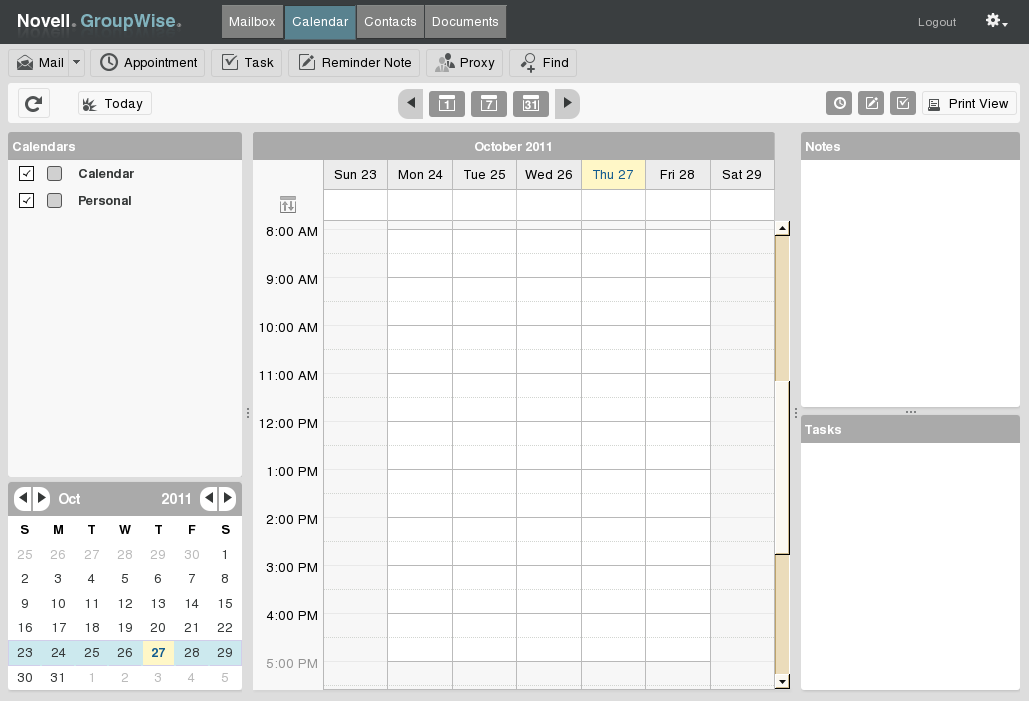
You can change the default to the Day view.
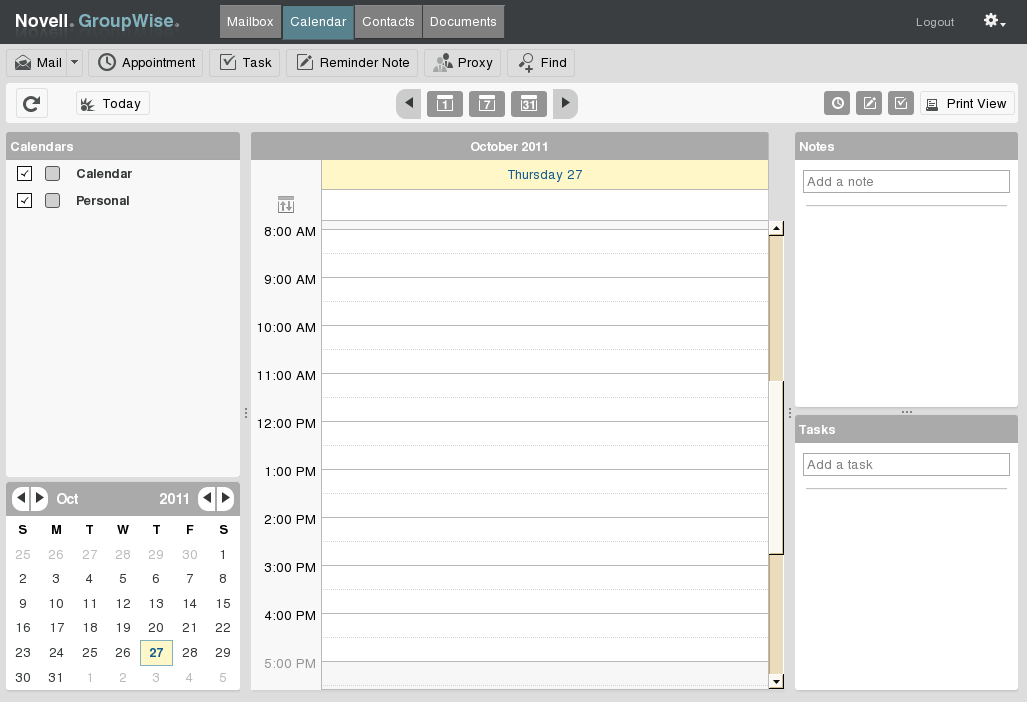
Or you can change the default to the month view.
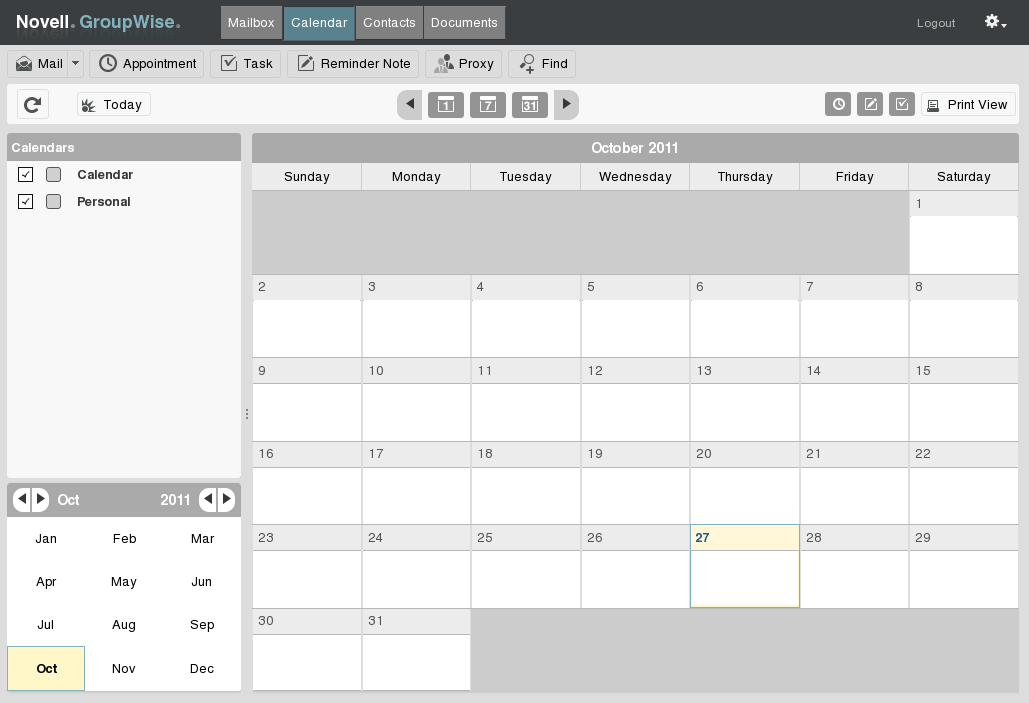
The default you select affects how the Calendar displays for GroupWise users to access their mailboxes through this instance of the WebAccess Application.
To change the default Calendar view:
-
Open the webacc.cfg file in a text editor.
-
Search to find the following line:
User.Calendar.defaultView=
-
Change Week to Day or Month.
-
Save the webacc.cfg file.
-
Skip to Section 62.1.6, Putting WebAccess Configuration Changes into Effect.
62.3.5 Customizing the Default List Functionality
By default, in lists of items, contacts, and Find results, GroupWise WebAccess users can Shift+click and Ctrl+click to select multiple items to perform an action on.
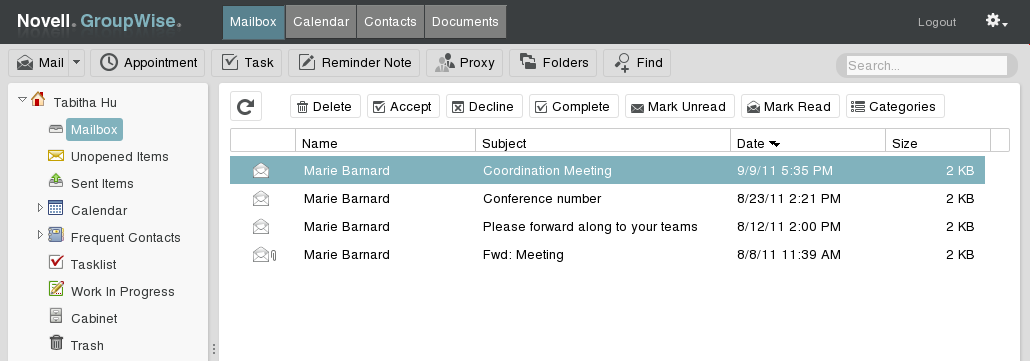
Some Web-based interfaces use check boxes for multiple selection. This interface option is also available for GroupWise WebAccess.
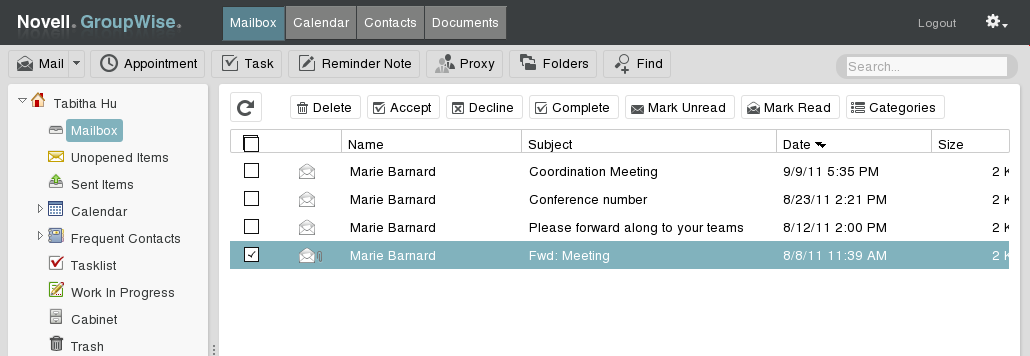
To configure WebAccess to display check boxes:
-
Open the webacc.cfg file in a text editor.
-
Search to find the following line:
List.Checkboxes.show=
-
Change false to true.
-
Save the webacc.cfg file.
-
Skip to Section 62.1.6, Putting WebAccess Configuration Changes into Effect.
62.3.6 Enabling an LDAP Address Book
You can configure WebAccess to access an LDAP directory as if it is a GroupWise address book.
-
Open the webacc.cfg file in a text editor.
-
Search to find the following line:
User.Access.LDAP=false
-
Change false to true to enable users to access an LDAP address book.
-
Save the webacc.cfg file.
-
Open the ldap.cfg file in a text editor.
-
Replace the sample information in the ldap.cfg file with the specific information for the LDAP directory that you want users to access as a GroupWise address book.
-
Save the ldap.cfg file.
-
Follow the instructions in Section 62.1.6, Putting WebAccess Configuration Changes into Effect.
-
Verify that the LDAP directory is available as a GroupWise address book:
-
In WebAccess, open a new item.
-
Click , then click the icon
 .
.
-
Expand the list of address books, then select the LDAP address book.
-
-
(Conditional) If the LDAP address book does not appear in the list:
-
Check your modifications to the webacc.cfg file and ldap.cfg file for errors.
-
Check the WebAccess Application log file for error messages.
For assistance, see Section 63.2, Using WebAccess Application Log Files.
-
Resolve the problem, so that the LDAP address book appears in the list of address books.
-
-
Verify that the LDAP address book works as expected:
-
Send a message to a recipient in the LDAP address book.
-
Verify that the message was delivered successfully.
-
-
Notify GroupWise users that the LDAP address book is available, and explain to them how to access it.
The LDAP address book is available only in the Address Selector and only in WebAccess. It is not available in the GroupWise client.